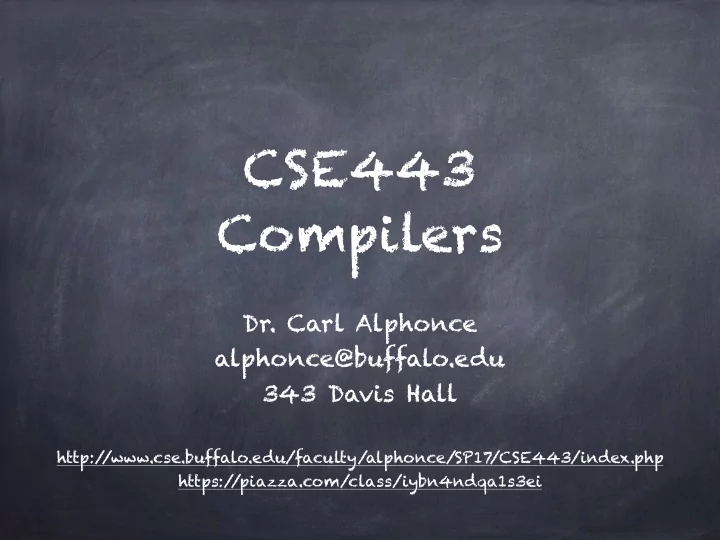

CSE443 Compilers Dr. Carl Alphonce alphonce@buffalo.edu 343 Davis Hall http:/ /www.cse.buffalo.edu/faculty/alphonce/SP17 /CSE443/index.php https:/ /piazza.com/class/iybn4ndqa1s3ei
Phases of a Syntactic compiler structure Figure 1.6, page 5 of text
Table-driven predictive parsing Here we trade the implicit stack that the recursing parsing algorithm uses for an explicit stack.
Recall the parse-table M NON id + * ( ) $ TERMINALS E E -> T E' E -> T E' E' E' -> 𝜁 E' -> 𝜁 E' -> + T E' T T -> F T' T -> F T' T' T' -> 𝜁 T' -> 𝜁 T' -> 𝜁 T' -> * F T F F -> id F -> ( E )
Algorithm 4.34 [p. 226] INPUT: A string 𝜕 and a parsing table M for a grammar G=(N,T,P,S). OUTPUT: If 𝜕∈𝓜 (G), a leftmost derivation of 𝜕 , error otherwise input $ 𝜕 stack S M parser $ output
Algorithm 4.34 [p. 226] Let a be the first symbol of 𝜕 Let X be the top stack symbol while (X ≠ $) { if (x == a) { pop the stack, advance a in 𝜕 } else if (X is a terminal) { error } else if (M[X,a] is blank) { error } else if (M[X,a] is X -> Y 1 Y 2 … Y k ) { output X -> Y 1 Y 2 … Y k pop the stack push Y k … Y 2 Y 1 onto the stack } Let X be the top stack symbol } Accept if a == X == $
INPUT (a) STACK (X) OUTPUT id + id * id $ E $ E -> T E' id + id * id $ T E' $ T -> F T' id + id * id $ F T' E' $ F -> id id + id * id $ id T' E' $ id + id * id $ T' E' $ T' -> 𝜁 id + id * id $ E' $ E' -> + T E' id + id * id $ + T E' $ id + id * id $ T E' $ T -> F T' id + id * id $ F T' E' $ F -> id id + id * id $ id T' E' $ id + id * id $ T' E' $ T' -> * F T' id + id * id $ * F T' E' $ id + id * id $ F T' E' $ F -> id id + id * id $ id T' E' $ id + id * id $ T' E' $ T' -> 𝜁 id + id * id $ E' $ E' -> 𝜁 id + id * id $ $ Since both a and X are $, accept
Recommend
More recommend